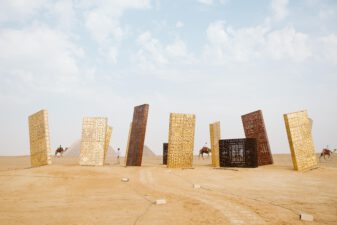 Taking irrigated water from the Nile, the Toshka pumping station in upper Egypt was supposed to help combat encroaching desert
Taking irrigated water from the Nile, the Toshka pumping station in upper Egypt was supposed to help combat encroaching desert
Political tension in Egypt in the aftermath of the revolution which began nearly two years ago, has hit tourism, led to high food prices, and caused an economic slowdown which is raising food security concerns. In 2012, Egypt was the world’s largest wheat importer (read this story on how wheat connects the planet), shipping in 11.5 million tons, and highlighting the gap between official food sustainability goals and reality.
“There is an urgent need to increase wheat productivity,” said Nagui Saeed, head of Egypt’s Wheat Producers’ Association – not just to conserve foreign currency but also to cater for Egypt’s growing population, which has nearly doubled in the last 30 years to 83 million.
Egypt’s long-term food security faces a number of challenges: nearly 99 percent of the population live on about 4 percent of the land (adjacent to the River Nile where most of the fertile land is).
Arable land covers around 3 percent of the country, and is under threat from desertification, urbanization and salination, particularly north of the Aswan High Dam, leading to the loss of an estimated 11,736 hectares of agricultural land every year.
The grand dream has always been to transform little-used desert areas and expand out of the densely-populated Nile valley.
What happened to Mubarak’s Toshka project?
In the mid-1990s former leader Hosni Mubarak initiated the Toshka Project (also known as the New Valley Project) to cultivate 202,347 hectares of farmland in the western desert, irrigating it with water from nearby Lake Nasser, a vast man-made lake created by the construction of the Aswan High Dam on the Nile in the south. (We covered in-depth what happened to Toshka here).
Funding problems, mismanagement and wavering political support have hindered the large-scale project, which nevertheless still looms large in discussions on food self-sufficiency.
[youtube]http://www.youtube.com/watch?v=DyG94Oiaq_Y[/youtube]
But in the current political instability, the dream of a single project turning vast tracts of desert into grain farms looks more like the pet-project of an authoritarian leader than the most pressing priority for the newly elected government.
The Muslim Brotherhood, to which President Mohamed Morsi belongs, opposes the scheme, but the wider policy idea of improving food security for a growing population remains part of state policy.
How can current farms be improved and expanded?
“There is determination at the national level to achieve self-sufficiency in wheat,” Iman Sadek, a senior researcher from the Agricultural Research Academy (within the Ministry of Agriculture), and the head of the National Wheat Campaign (a project that aims to reduce Egypt’s wheat production-consumption gap), told IRIN.
Using desert land seems a key part of the solution, she says.
“But we have to bear in mind that the variety of wheat that can be grown in the desert can be different from the one grown in the Nile valley or delta.”
Away from mega-projects, some progress has been made, if slowly.
According to the Ministry of Agriculture, Egypt produced 8.7 million tons of wheat in 2012, 4 percent more than in the previous year, itself a good year.
“Productivity improvements can be done by both increasing the lands cultivated with wheat and also applying new technologies to raise the productivity of present fields”, said Saeed of the Wheat Producers’ Association.
“There is determination at the national level to achieve self-sufficiency in wheat” – Iman Sadek, senior researcher, Agricultural Research Academy The total land area sown with wheat has increased to 1.2 million hectares in 2012, from 1.1 million hectares in 2011, according to Agriculture Minister Salah Abdel Mo’men.
The new Egyptian government has a target of producing locally 75 percent of domestic wheat needs within the next three years. Pilots carried out in 2011 and 2012 by the Egyptian Agriculture Research Centre and Egypt’s Academy of Scientific Research and Technology have shown productivity can be boosted by 30 percent.
The increased yields were attributed to new varieties developed by the Agricultural Research Academy and new agriculture methods (raised bed planting).
What’s holding back greater food production?
Agriculture needs fertile land and water, both of which are in short supply in Egypt, but when it comes to persevering fertile land, water is ironically the biggest threat.
The Nile Delta generates a third of national agricultural production, but saltwater intrusion is now a major problem with the Mediterranean having risen 20cm in the past century.
Egypt is particularly exposed to climate change.
The country has an annual water shortfall of seven billion cubic metres, with the Nile the only regular freshwater source, and itself threatened by growing water-use upstream.
Agriculture will bear the strain of any decrease in water availability, consuming as it does 85 percent of supply, according to Egypt’s state of the environment report, which criticises the “the continued use of unsustainable agricultural methods of planting and irrigation management”.
With only 55 billion cubic metres every year, Egypt does not have enough water to quench the thirst of its growing population and irrigate its farmland (around 3.3 million hectares in total).
What’s the government doing?
Current the government is importing cereals from global markets, leaving the country’s poor heavily exposed to fluctuations in world food prices, effectively importing water in food form.
The lack of security on the open market – as shown when Russia banned wheat exports in 2010 – has even prompted the government to consider growing cereals in other countries, including Sudan.
A delegation from the Ministry of Agriculture is preparing to visit Sudan later this year to examine the possibility of growing wheat on as many as 470,000 hectares of Sudanese land.
While better use of current water supplies seems to be the most practicable idea for improving national food security, others see a broader solution just around the corner.
Scientists say the western desert is home to a huge groundwater reservoir that could help Egypt reclaim up to 1.5 million hectares of land in the future.
Khaled Abd El-Kader, a professor emeritus of stratigraphy from Assuit University, used satellite images of the Great Sand Sea, an area in the western desert that contains huge sand dunes up to 100 metres in height, to search for ground water.
Findings from a field trip to the area concluded that there may be a huge and accessible underground water oasis spanning Chad, Egypt, Libya and Sudan.
An earlier study by water expert Maghawry Diab pointed to the presence of huge amounts of underground water in the Western Desert, enough for the reclamation of 261,000 hectares of land, and suggested that Egypt could do without the Nile for reclamation purposes if this source could be tapped.
The government, according to Sadek of the Agricultural Research Academy, is digging experimental wells in the desert to try and reach this water but in the meantime researchers at the Academy are focusing on new varieties of drought- and salinity-resistant wheat.
(This article is reprinted from the UN reporting service, IRIN); top image via panopticon




Problems related to water will accelerate in all countries … and hot countries like Egypt will suffer more than the Nordic countries. It is true that we must begin to implement concrete projects to conserve water for future generations of Egyptians.